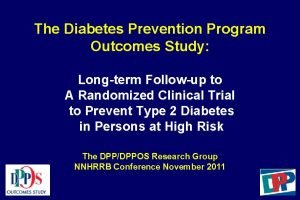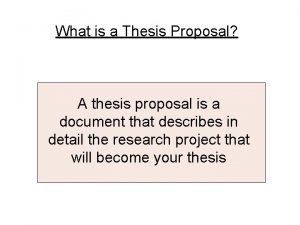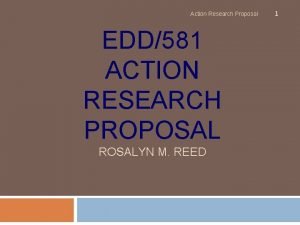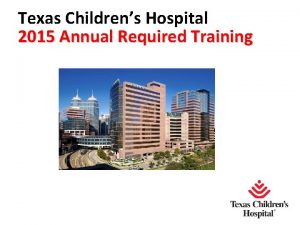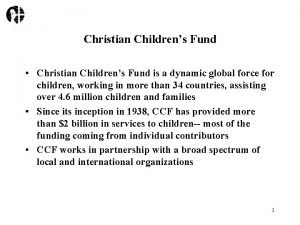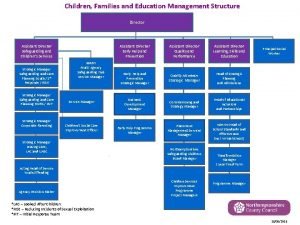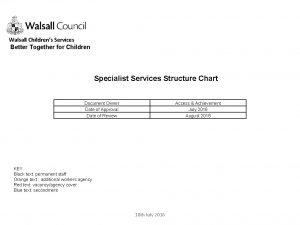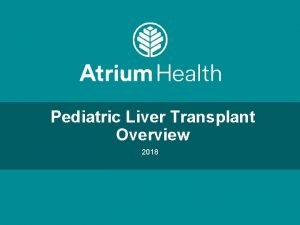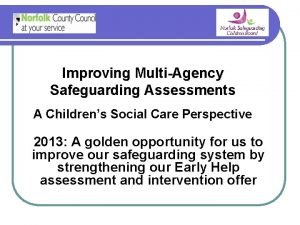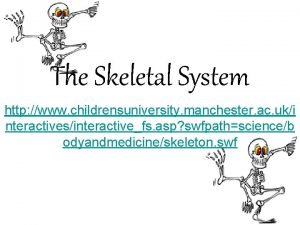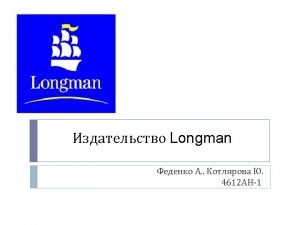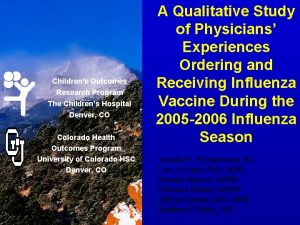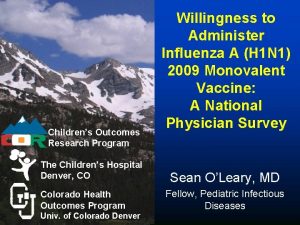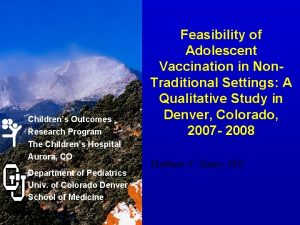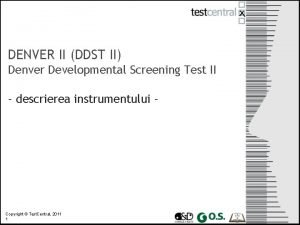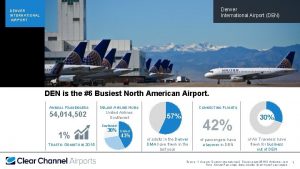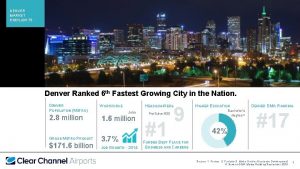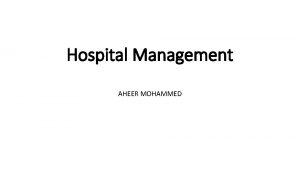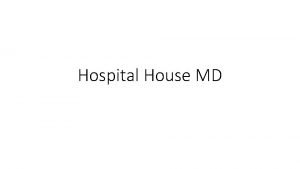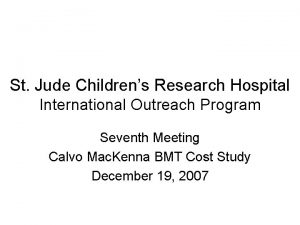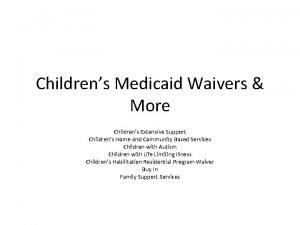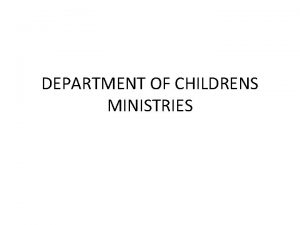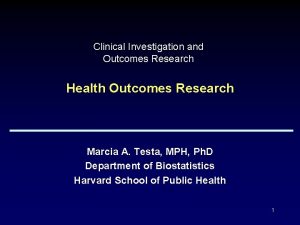Childrens Outcomes Research Program The Childrens Hospital Denver






























- Slides: 30

Children’s Outcomes Research Program The Children’s Hospital Denver, CO Colorado Health Outcomes Program U. Colo. at Denver and HSC Aurora, CO The Impact of Influenza Vaccine Shortages on Pediatricians During the 2004 -2005 Influenza Season Matthew F. Daley, MD

Vaccine Policy Collaborative Initiative § § § Allison Kempe, MD, MPH (PI) Brenda L. Beaty, MSPH § Miriam Dickinson, Ph. D § Jennifer Barrow, MSPH § Christine Babbel, MSPH § CDC Collaborator § Shannon Stokley, MSPH John Steiner, MD, MPH Arthur Davidson, MD, MSPH Stephen Berman, MD Lori A. Crane, Ph. D, MPH

Study Objectives To assess, in a national survey of pediatricians, the impact of the 2004 -2005 influenza vaccine shortage on: • Vaccine ordering, supplies, and redistribution • Vaccination and referral practices • Future vaccination plans

Study Setting § Survey period: March – June 2005 § Conducted in a sentinel physician network, developed as part of the Vaccine Policy Collaborative Initiative

Creation of Sentinel Physician Network (1) § Goal: develop group of physicians, representative of primary care pediatricians nationwide, to rapidly respond to immunizationrelated surveys § Demographic data from American Academy of Pediatrics (AAP) periodic survey used to create a matrix of expected proportions of U. S. pediatricians by: • Region of country (NE, S, MW, W) • Location (inner-city, non-inner-city/suburban, rural) • Setting (private, managed care, community/hospitalbased)

Creation of Sentinel Physician Network (2) § Proportions from this matrix used to determine sampling quotas for each of 36 “cells, ” based on targeted study population of 400 physicians § To develop network, participants recruited from random sample of 2500 AAP members § Respondents were placed into sampling cells based on their region, location, and setting: • Respondents practicing < 50% primary care excluded • For cells with excess (> 110% predicted) respondents, a subset randomly selected for study • For cells with too few (< 90% predicted) respondents, an additional recruitment attempt was made

Creation of Sentinel Physician Network (3) § Final Sentinel Network • 427 pediatricians • 28 of 36 cells (78%) with expected number of physicians • 8 cells underrepresented by 15 physicians total (range: 1 -4 physicians underrepresented per cell) § Immunization-related attitudes of this network found to be generally comparable to attitudes of pediatricians randomly sampled from the American Medical Association (AMA) masterfile (Crane LA et al, Poster # 120)

Survey Design § Pilot-tested in community advisory panel, a group of 6 pediatricians from throughout U. S. § Conceptual areas: • Experiences with vaccine ordering, redistribution, and supplies • Vaccination practices, particularly regarding prioritizing vaccine and referring patients elsewhere for vaccination • Future vaccination plans

Survey Administration § Surveyed by either internet or mail, depending on preference § Internet (n=163 total): • Web-based (Zoomerang, Mill Valley, CA) • Emails with links to survey sent • Up to 9 emails sent over a 6 -week period § Mail (n=264 total): • Paper-based, self-administered • Up to 3 surveys sent over a 6 -week period

RESULTS: Survey Response § 352 of 427 (82%) responded § 4 respondents did not give influenza vaccine in their practices, and were excluded from further analyses § Respondents were not significantly different from non-respondents with respect to: • • Mean age Practice setting (i. e. private, other) Practice location (i. e. inner-city, suburban, rural) Region of the country

Additional Characteristics of Respondents’ Practices Respondents (n=352) Location of practice Urban, inner-city 10% Non-inner-city/suburban 74% Rural 16% Proportion 2 -18 y. o. patients with chronic illness < 10% 42% 10 -24% 49% 25% 9%

Results: Objective 1 § To assess the impact of the 2004 -2005 influenza vaccine shortage on vaccine ordering, supplies, and redistribution

Prior to 2004 -2005 Shortage, Which Vaccines Did Respondents Order, and From Whom? (n=328) Note: 6% did not order vaccine prior to shortage or did not know source of vaccine

After learning about vaccine shortages, respondents purchased or were given additional injectable vaccine… Directly from manufacturer (i. e. Aventis-Pasteur) 16% Directly from another practice 14% From public health entity (e. g. public health dept. ) 23% From another source 8% From ONE OR MORE above sources 48%

After learning about vaccine shortages, respondents gave away or sold vaccine… To another practice 29% To a public health entity 15% To other entities 8% To ONE OR MORE above sources 37%

Percent Who Experienced a Vaccine Shortage for High-Risk Patients at Some Point During 2004 -2005 Shortage 43% (n=145) No Shortage 57% (n=194)

Among Respondents who Experienced Shortage for High-Risk Patients (n=145), Shortage Months

By End of Season, Proportion of Total Doses Ordered Prior to Shortage That Were Received (n=328)

Proportion of Total Doses Received That Were Left Over at the End of Season

Results: Objective 2 § To assess the impact of the 2004 -2005 influenza vaccine shortage on vaccination and referral practices

Vaccination Practices § Means used to encourage influenza vaccination during the 2004 -2005 season: • Mail/phone reminders to targeted groups: 58% • Extended hours: 58% • Vaccination given at office visits made for other purposes: 96% • Vaccination without an appointment: 50%

Vaccination Practices: Prioritization Priority Given (Among Respondents Who Gave Vaccine to Group) Group Gave Vaccine Low Moderate High Children 6 -23 months old 95% 2% 19% 79% Persons w/ high-risk conditions 98% 1% 5% 94% Healthy persons ≥ 2 years old 29% 79% 18% 3% Contacts of high-risk groups 62% 20% 59% 21% Contacts of infants < 6 months old 63% 15% 44% 41%

Referral Practices § Because of the 2004 -2005 influenza vaccine shortage, high-risk patients referred to: • • • Another practice: 13% A public health clinic: 41% A pharmacy, supermarket, or other business: 22% Another location: 6% To ONE OR MORE above locations: 47%

How Did 2004 -2005 Season Compare with the Previous Season? Many/ About the Many/ somewhat same somewhat more fewer Number of high-risk patients immunized (04 -05 vs. 03 -04) 50% 40% 9% Number of unimmunized patients with serious influenza complications (04 -05 vs. 03 -04) 8% 51% 40% Number of unimmunized patients given antivirals (04 -05 vs. 03 -04) 26% 47% 27%

Results: Objective 3 § To assess the impact of the 2004 -2005 influenza vaccine shortage on future vaccination plans

Plans for the 2005 -2006 Influenza Season § 99. 7% of respondents plan to give influenza vaccine in their practice § Of those planning to give vaccine in 2005 -2006: • • 59% plan to order more doses 47% plan to order earlier in season 14% plan to not schedule influenza clinics 43% plan to make practice changes to allow better targeting of high-risk patients

Limitations § Sentinel physician network was designed to be representative of AAP overall; it is possible network differed from AAP members in some way that was not measured § Possible that survey non-respondents had different experiences with vaccine shortages than did respondents § Reports of vaccine supplies based on physician estimates and were not verified § “If you have seen one influenza season, you’ve seen one influenza season. ”

Conclusions § During 2004 -2005, fewer than one-half of surveyed pediatricians experienced influenza vaccine shortages for high-risk patients § Wide variation in vaccine supplies: • Most received the majority of vaccine ordered • 10% received less than one-half of their ordered doses • 49% had vaccine left over at end of season § There was extensive redistribution of vaccine and referral of patients, primarily involving the public health system

Conclusions (2) § The vast majority of surveyed pediatricians (91%) estimated that the same number or more of their highrisk patients received influenza vaccine in 2004 -2005 compared with the prior year § Pediatricians placed a higher priority on immunizing children with high-risk conditions and young children than on immunizing contacts of high-risk groups § Almost all surveyed pediatricians plan to provide influenza vaccination in 2005 -2006, with 59% planning to order more doses

Acknowledgments This investigation was funded by the Centers for Disease Control and Prevention, through the Rocky Mountain Prevention Research Center, Denver, CO
 Program specific outcomes nba
Program specific outcomes nba Diabetes prevention program outcomes study
Diabetes prevention program outcomes study Expected results research proposal example
Expected results research proposal example Expected outcomes in research examples
Expected outcomes in research examples Functions of hospital pharmacist
Functions of hospital pharmacist Moli texaschildrens
Moli texaschildrens Childrens christian fund
Childrens christian fund Childrens services
Childrens services Childrens services walsall
Childrens services walsall Levine childrens
Levine childrens 23 april international children's day turkey
23 april international children's day turkey Kirklees safeguarding childrens board
Kirklees safeguarding childrens board Traditional literature quiz
Traditional literature quiz Skeletal system
Skeletal system Childrens picture dictionary
Childrens picture dictionary Black childrens memorial
Black childrens memorial 1 year old fever
1 year old fever History of childrens literature
History of childrens literature Junior book awards 2018
Junior book awards 2018 Hình ảnh bộ gõ cơ thể búng tay
Hình ảnh bộ gõ cơ thể búng tay Slidetodoc
Slidetodoc Bổ thể
Bổ thể Tỉ lệ cơ thể trẻ em
Tỉ lệ cơ thể trẻ em Gấu đi như thế nào
Gấu đi như thế nào Tư thế worms-breton
Tư thế worms-breton Bài hát chúa yêu trần thế alleluia
Bài hát chúa yêu trần thế alleluia Môn thể thao bắt đầu bằng chữ đua
Môn thể thao bắt đầu bằng chữ đua Thế nào là hệ số cao nhất
Thế nào là hệ số cao nhất Các châu lục và đại dương trên thế giới
Các châu lục và đại dương trên thế giới Công thức tiính động năng
Công thức tiính động năng Trời xanh đây là của chúng ta thể thơ
Trời xanh đây là của chúng ta thể thơ

